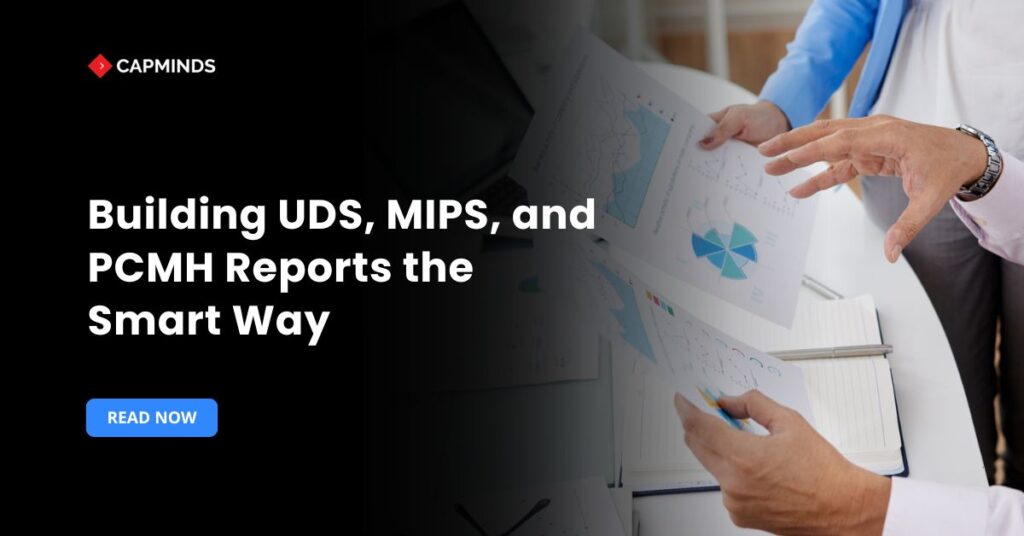Building UDS, MIPS, and PCMH Reports the Smart Way
Healthcare organizations must compile comprehensive reports like UDS, MIPS, and PCMH to stay compliant, secure funding, and monitor care quality. Federally qualified health centers rely on accurate UDS data reporting to maintain their HRSA funding, while MIPS performance affects Medicare reimbursements and penalties. Yet gathering and validating all the necessary data is challenging.
Fragmented systems, manual data entry, and evolving rules make reporting a time-consuming burden. Digital health platforms and modern EHR tools offer a smarter approach. By automating data capture and analytics, they simplify report generation and improve accuracy.
The Challenges in UDS, MIPS, and PCMH Reporting
Complex Data Collection
UDS, MIPS, and PCMH each require dozens of clinical and operational measures.
- For UDS, health centers must report patient demographics, disease control, service utilization, staffing, and finances.
- MIPS involves multiple quality, cost, and improvement categories, and PCMH programs track access, care coordination, and patient experience.
- Pulling all that data from separate systems is difficult.
- Often, clinics have information scattered across different EHR modules, registries, and spreadsheets, making it hard to consolidate into one report.
This fragmentation leads to manual work and errors. Manual processes and outdated spreadsheets are common: “Some providers rely on basic tracking systems that don’t integrate with EHRs,” causing missing or inconsistent data.
Data Quality and Accuracy
Even small mistakes can derail a report. Incomplete or incorrectly entered data may trigger submission failures or penalties.
- For example, missing patient visits or miscoded diagnoses can distort quality scores in MIPS or UDS.
- Inconsistent data entry practices or legacy systems lacking validation lead to “inconsistent data entry, missing patient records, and incorrect reporting” that undermine UDS accuracy.
- Across programs, these errors can add up to significant compliance and funding risks.
Integration Gaps
Many EHRs and billing systems were not originally built to produce UDS/MIPS/PCMH reports out of the box. As a result, staff often have to manually extract data or cobble together multiple reports.
Not all EHR platforms support automated UDS data export, “leading to manual data collection burdens”. Likewise, organizations spanning multiple clinics or hospitals may operate different EHR systems for each site. Each system must be accessed separately, a process that is slow and error-prone.
Complex and Changing Requirements
UDS, MIPS, and PCMH reporting rules evolve frequently. Every year brings updated measure definitions and submission deadlines.
Health centers must keep up with HRSA’s UDS manual updates and MIPS policy changes, which can confuse staff. Clinics often struggle “keeping up with regulatory changes,” requiring constant retraining and process tweaks. Similarly, MIPS has strict submission deadlines; missing them can incur heavy penalties.
Resource and Time Constraints
Preparing these reports is labor-intensive. Clinicians and administrators must spend precious time gathering documentation rather than caring for patients.
Many practices lack dedicated reporting teams. As one source notes, UDS reporting “requires detailed knowledge of compliance guidelines and can be time-consuming”. Rushed, last-minute efforts to finish reports also increase the chance of mistakes.
Smart Solutions Through Digital Health Platforms
Digital health technologies, primarily modern EHR systems and integrated analytics platforms, can overcome these obstacles by automating data workflows and providing real-time insights. Rather than manually compiling information at year-end, clinics can build UDS, MIPS, and PCMH reports progressively throughout the year. Key strategies include:
Automated Data Capture and Validation
Today’s EHRs can be configured to tag and collect quality metrics at the point of care. Instead of scanning records after the fact, relevant data is captured in structured fields. Built‑in validation rules immediately flag missing or out-of-range values. This dramatically reduces transcription errors and ensures that quality measures are based on complete data.
Integrated Analytics Dashboards
Digital reporting often relies on continuous monitoring, not just annual snapshots. By using embedded dashboards and business intelligence tools, practices can track key performance indicators like UDS measures or MIPS scores in real time.
- For example, health centers frequently integrate analytics software to track and validate UDS metrics throughout the year.
- These dashboards highlight gaps or trends early, so staff can address them before deadlines.
- In the MIPS context, constant tracking means providers can adjust strategies by category and avoid last-minute scrambles.
Related: Still Using Excel to Track Healthcare Assets? Here’s What You’re Risking
Seamless Interoperability
Data needed for quality reports often lives in multiple systems: EHR, patient registries, billing, etc.
New interoperability standards enable these sources to feed into centralized reporting platforms. This reduces the need to manually merge files.
- According to industry experts, organizations now create “an inventory of their large providers and the EHRs they use” and gradually integrate data from each source.
- In effect, the data-sharing infrastructure collects clinical, administrative, and claims data into one place.
- Over time, this foundation supports faster and more comprehensive reporting for UDS/MIPS/PCMH.
Automated Reporting Tools
Beyond data collection, specialized software can automatically generate the official report formats. For example, many practices use EHR modules or third-party tools to compile UDS figures and submit them to HRSA’s Electronic Handbook.
Similarly, MIPS reporting platforms can calculate scores and prepare CMS submissions, often with built-in compliance checks. These tools cut down on manual calculations and formatting work. For instance, one guideline suggests implementing “automated validation tools in EHR systems” to reduce reporting errors.
Staff Training and Workflow Alignment
Digital solutions also streamline workflow by making reporting intuitive for clinical staff. Rather than relying on memory or hidden codes, providers get prompts and templates as they enter patient information.
- Using EHR prompts for reminders or checklists can boost performance on quality measures.
- Likewise, built-in training resources and help articles within the platform can guide users on documentation requirements.
- Empowered with user-friendly technology, staff can perform their usual duties and simultaneously capture the data needed for UDS/MIPS/PCMH with minimal extra effort.
Proactive Performance Review
One big advantage of smart reporting tools is year-round tracking. Rather than waiting until the deadline, teams can set up regular “check-ins” on their progress.
Automated alerts can warn if a denominator is low or if a key measure is off-target. This approach aligns with recommendations that providers “track data throughout the year” and “use the right tools” to make reporting efficient. By catching issues early, clinics improve accuracy and often achieve better outcomes.
Smart Reporting for Each Program
UDS Reporting
UDS reporting for health centers required to submit UDS, technology can streamline every step. Many modern EHRs have UDS-reporting features that automatically pull data on patient visits, provider productivity, and clinical outcomes.
Analytics dashboards can display up-to-date UDS measure values, making it easy to see, for example, whether blood pressure control or immunization rates are on track.
By continuously monitoring these metrics, centers avoid the “last-minute data issues” that often plague paper-based UDS preparations.
- Because UDS covers clinical as well as operational and financial metrics, integrated platforms are especially useful.
- They bring together patient records, payroll, and billing data into one system. This eliminates double work.
- Moreover, automated UDS validation checks can catch anomalies early.
- If an expected demographic field is empty or a number falls outside logical bounds, the system can flag it for review.
In practice, providers have found that digital tools not only save time but also improve funding outcomes. With cleaner data and a simpler submission process, centers are more likely to meet HRSA requirements and avoid funding cuts.
Over time, the data collected through these systems also enables more insightful community health planning, further justifying technology investments.
Related: What is UDS Reporting in Healthcare? Everything You Need to Know
MIPS Reporting
MIPS reporting is notorious for its complexity, including four weighted categories and dozens of measures. Implementing a digital solution can significantly lighten this load.
EHR integration can automatically capture Quality measures during patient visits, and patient registries can help manage Improvement Activities like care coordination or patient engagement. This reduces the need for providers to manually hunt down data.
- When data flows into a central system, generating the MIPS submission becomes easier.
- Automated platforms can calculate scores and check compliance with CMS rules, greatly reducing the risk of simple errors.
- Using tech streamlines the entire workflow, as one analysis notes:
- EHR integration and automated reporting tools help reduce mistakes and allow real-time monitoring.
- Instead of fearing a last-minute scramble, practices can break reporting into manageable steps throughout the year.
Technology also helps avoid missed deadlines. Automated reminders and calendars within an EHR can alert administrators to upcoming MIPS submission dates.
Regular progress reports keep the team on track. This kind of proactive approach directly addresses the common challenge that delays often happen when providers underestimate how long data collection and validation take. By leveraging digital schedules and alerts, practices can file on time and with confidence, maximizing their incentive payments.
PCMH Reporting
Reporting for Patient-Centered Medical Home recognition also benefits from digital transformation. PCMH standards require tracking measures on access, care management, patient experience, and more. Coordinating data across these domains typically involves multiple staff roles and data sources. A unified digital platform can bring it all together.
Appointment and scheduling modules can automatically report on timely access measures, while care management tools can log team huddles or follow-up calls. Patient feedback captured via portals or surveys can feed directly into the patient engagement metrics. By storing this information in the EHR or a connected registry, clinics avoid paper checklists and manual chart audits.
- Just as with other quality programs, adopting standards-based data exchange is key.
- NCQA and industry experts advocate moving PCMH reporting toward digital quality measures.
- This means using interoperable formats so that EHRs can produce the needed data feeds.
- When fully implemented, this lets practices run PCMH measure calculations continuously.
- The result is a smoother renewal process: instead of assembling binders of charts, staff can generate reports from the system, confident that the data is consistent and up to date.
Moreover, digital tracking provides actionable insights for ongoing improvement. Dashboards can show which aspects of PCMH care are lagging, prompting targeted interventions. Technology turns the PCMH reporting exercise into a real-time management tool.
Though building this infrastructure requires investment, it aligns with broader healthcare trends. As one analysis notes, shifting to digital quality measurement “will improve accuracy and efficiency of quality measurement”.
Ready to Make Reporting Easy, Accurate & Compliant? CapMinds Can Help.
UDS, MIPS, and PCMH reporting doesn’t have to be a resource-draining process.
With CapMinds’ smart digital health solutions, your organization can simplify reporting, improve data quality, and stay fully compliant, without the last-minute scramble.
Our tailored services include:
- Custom EHR/EMR solutions that support structured data capture for reporting needs
- Seamless interoperability services to unify scattered data from multiple systems
- Integrated analytics dashboards for real-time tracking of UDS, MIPS, and PCMH measures
- Automated reporting tools to reduce manual work and minimize submission errors
- EHR optimization and customization for compliance with ever-changing regulatory standards
Let CapMinds be your technology partner in transforming complex healthcare reporting into a streamlined, strategic advantage.
Get in touch today to power smarter reporting with CapMinds!



